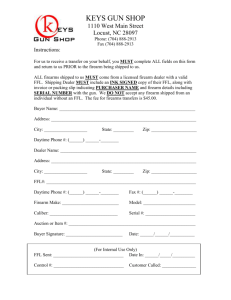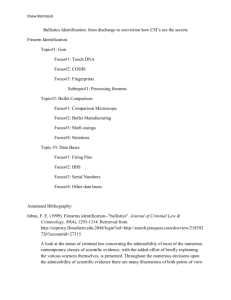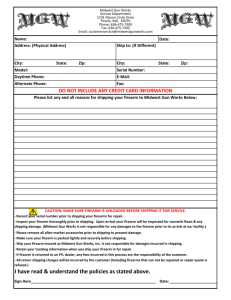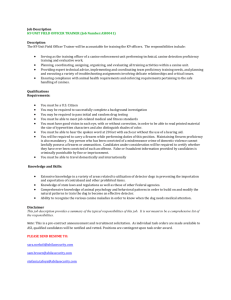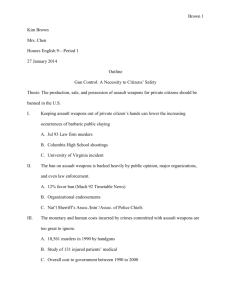constructive possession
advertisement
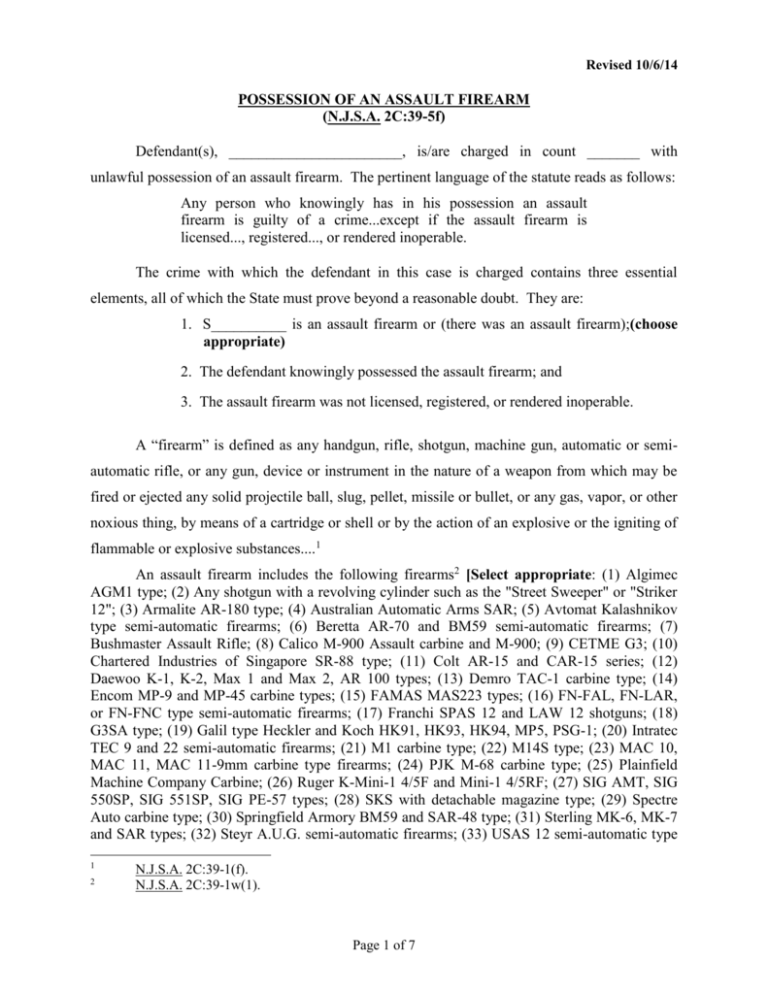
Revised 10/6/14 POSSESSION OF AN ASSAULT FIREARM (N.J.S.A. 2C:39-5f) Defendant(s), _______________________, is/are charged in count _______ with unlawful possession of an assault firearm. The pertinent language of the statute reads as follows: Any person who knowingly has in his possession an assault firearm is guilty of a crime...except if the assault firearm is licensed..., registered..., or rendered inoperable. The crime with which the defendant in this case is charged contains three essential elements, all of which the State must prove beyond a reasonable doubt. They are: 1. S__________ is an assault firearm or (there was an assault firearm);(choose appropriate) 2. The defendant knowingly possessed the assault firearm; and 3. The assault firearm was not licensed, registered, or rendered inoperable. A “firearm” is defined as any handgun, rifle, shotgun, machine gun, automatic or semiautomatic rifle, or any gun, device or instrument in the nature of a weapon from which may be fired or ejected any solid projectile ball, slug, pellet, missile or bullet, or any gas, vapor, or other noxious thing, by means of a cartridge or shell or by the action of an explosive or the igniting of flammable or explosive substances....1 An assault firearm includes the following firearms2 [Select appropriate: (1) Algimec AGM1 type; (2) Any shotgun with a revolving cylinder such as the "Street Sweeper" or "Striker 12"; (3) Armalite AR-180 type; (4) Australian Automatic Arms SAR; (5) Avtomat Kalashnikov type semi-automatic firearms; (6) Beretta AR-70 and BM59 semi-automatic firearms; (7) Bushmaster Assault Rifle; (8) Calico M-900 Assault carbine and M-900; (9) CETME G3; (10) Chartered Industries of Singapore SR-88 type; (11) Colt AR-15 and CAR-15 series; (12) Daewoo K-1, K-2, Max 1 and Max 2, AR 100 types; (13) Demro TAC-1 carbine type; (14) Encom MP-9 and MP-45 carbine types; (15) FAMAS MAS223 types; (16) FN-FAL, FN-LAR, or FN-FNC type semi-automatic firearms; (17) Franchi SPAS 12 and LAW 12 shotguns; (18) G3SA type; (19) Galil type Heckler and Koch HK91, HK93, HK94, MP5, PSG-1; (20) Intratec TEC 9 and 22 semi-automatic firearms; (21) M1 carbine type; (22) M14S type; (23) MAC 10, MAC 11, MAC 11-9mm carbine type firearms; (24) PJK M-68 carbine type; (25) Plainfield Machine Company Carbine; (26) Ruger K-Mini-1 4/5F and Mini-1 4/5RF; (27) SIG AMT, SIG 550SP, SIG 551SP, SIG PE-57 types; (28) SKS with detachable magazine type; (29) Spectre Auto carbine type; (30) Springfield Armory BM59 and SAR-48 type; (31) Sterling MK-6, MK-7 and SAR types; (32) Steyr A.U.G. semi-automatic firearms; (33) USAS 12 semi-automatic type 1 2 N.J.S.A. 2C:39-1(f). N.J.S.A. 2C:39-1w(1). Page 1 of 7 POSSESSION OF AN ASSAULT FIREARM (N.J.S.A. 2C:39-5f) shotgun; (34) Uzi type semi-automatic firearms; (35) Valmet M62, M71S, M76, or M78 type semi-automatic firearms; or (36) Weaver Arm Nighthawk]. (Charge if applicable) A (Charge if applicable) is designated as an assault firearm. Any firearm manufactured under any designation which is substantially identical to any of the firearms listed in the statute is also an assault firearm. In this case, the State alleges that S_________ is substantially identical to _______________ which is designated in the statute.3 (Charge if appropriate: On the other hand, the defendant maintains ______________). (Include any of the three following definitions of assault firearm if material to the case) The term “substantial” means pertaining to the substance, matter, material or essence of a thing. The term “identical” means exactly the same. Hence, a firearm is substantially identical to another only if it is identical in all material, essential respects. A firearm is not substantially identical to a listed assault firearm unless it is identical except for differences which do not alter the essential nature of the firearm.4 The following are examples of manufacturer changes that do not alter the essential nature of the firearm: name or designation of the firearm; the color of the firearm; the material used to make the barrel or stock of the firearm; the material used to make a pistol grip; a modification of a pistol grip. This is not an exclusive list. A semi-automatic firearm should be considered to be “substantially identical,” that is, identical in all material respects, to a named assault weapon if it meets the below listed criteria: (Semi-automatic shotgun: Charge if applicable) An assault firearm also means a semi-automatic shotgun with either a magazine capacity exceeding six rounds, a pistol grip, or a folding stock.5 “Semi-automatic” means a firearm which fire a single projectile for each single pull of the trigger and is self-reloading or automatically chambers a round, cartridge, or bullet.6 A “pistol grip” means a well-defined handle, similar to that found on a handgun, that protrudes conspicuously beneath the action of the weapon, and 3 N.J.S.A. 2C:39-1w(2). Attorney General Guidelines Regarding the “Substantially Identical” Provision in the State’s Assault Firearm Laws (Aug. 1996); Coalition of New Jersey Sportsmen, Inc. v. Whitman, 44 F. Supp. 2d 666 D.N.J. (1999), aff 'd 263 F. 3d 157 (3d Cir. 2001). 5 N.J.S.A. 2C:39-1w(3). 6 N.J.S.A. 2C:39-1x. 4 Page 2 of 7 POSSESSION OF AN ASSAULT FIREARM (N.J.S.A. 2C:39-5f) which permits the shotgun to be held and fired with one hand.7 It includes a semi-automatic shotgun that has at least 2 of the following: 1. A folding or telescoping stock; 2. A pistol grip that protrudes conspicuously beneath the action of the weapon; 3. A fixed magazine capacity in excess of 5 rounds; and 4. An ability to accept a detachable magazine. (Semi-automatic rifle: Charge if applicable) An assault firearm also means a semi-automatic rifle with a fixed magazine capacity exceeding 15 rounds.8 “Semi-automatic” mean a firearm which fires a single projectile for each single pull of the trigger and is self-reloading or automatically chambers a round, cartridge, or bullet.9 It includes a semi-automatic rifle that has the ability to accept a detachable magazine and has at least 2 of the following: 1. a folding or telescoping stock; 2. a pistol grip that protrudes conspicuously beneath the action of the weapon; 3. a bayonet mount; 4. a flash suppressor or threaded barrel designed to accommodate a flash suppressor; and 5. a grenade launcher. (Semi-automatic pistol: Charge if applicable) A semi-automatic pistol that has an ability to accept a detachable magazine and has at least 2 of the following: 1. An ammunition magazine that attaches to the pistol outside of the pistol grip; 2. A threaded barrel capable of accepting a barrel extender, flash suppressor, forward handgrip, or silencer; 3. A shroud that is attached to, or partially or completely encircles, the barrel and that permits the shooter to hold the firearm with the nontrigger hand without being burned; 4. Manufactured weight of 50 ounces or more when the pistol is unloaded; and 7 8 N.J.S.A. 2C:39-1z. N.J.S.A. 2C:39-1(4). Page 3 of 7 POSSESSION OF AN ASSAULT FIREARM (N.J.S.A. 2C:39-5f) 5. A semi-automatic version of an automatic firearm. An assault firearm also means a part or combination of parts designed or intended to convert a firearm into an assault firearm, or any combination of parts from which an assault firearm may be readily assembled if those parts are in the possession or under the control of the same person.10 The second element that the State must prove beyond a reasonable doubt is that the defendant knowingly possessed the assault firearm. KNOWINGLY A person acts knowingly with respect to the nature of his/her conduct or the attendant circumstances if he/she is aware that his/her conduct is of that nature, or that such circumstance exist, or he/she is aware of a high probability of their existence. A person acts knowingly with respect to a result of his/her conduct if he/she is aware that it is practically certain that his/her conduct will cause such a result. “Knowingly,” “with knowledge” or equivalent terms have the same meaning. A person acts knowingly with respect to his/her conduct if he/she is aware that his/her conduct is of that nature. You must determine whether the defendant was aware of the nature of his/her conduct in this case. Since knowledge is a state of mind and cannot be seen and can only be determined by inference from conduct, words or acts, it can rarely be proved directly. Therefore, it is not necessary that witnesses be produced by the State to testify that a defendant said he/she knowingly did something. His/Her knowledge may be gathered from his/her acts and his/her conduct, and from all the surrounding circumstances reflected in the evidence you have heard and seen in this case. That is, you must be convinced beyond a reasonable doubt that the defendant in this case was aware that he/she had S________in his/her possession. POSSESSION11 The word “possess” as used in criminal statutes signifies a knowing, intentional control of a designated thing, accompanied by a knowledge of its character. Thus, the person must know or be aware that he/she possesses the item, in this case S______, and the person must know what it is that he/she possess or controls, in this case, that it is a firearm. The State need not prove that 9 10 11 N.J.S.A. 2C:39-1x. N.J.S.A. 2C:39-1w(5). Charge statutory inference in N.J.S.A. 2C:39-2, if applicable. Page 4 of 7 POSSESSION OF AN ASSAULT FIREARM (N.J.S.A. 2C:39-5f) defendant knew it was an assault firearm.12 This possession cannot merely be a passing control that is fleeting or uncertain in its nature. In other words, to “possess” within the meaning of the law, the defendant must knowingly procure or receive the item possessed or be aware of his/her control thereof for a sufficient period of time to have been able to relinquish control if he/she chose to do so. A person may possess S________ even though it was not physically on his/her person at the time of the arrest, if the person had in fact, at some time prior to his/her arrest, had control over it. When we speak of possession, we mean a conscious, knowing possession. The law recognizes two kinds of possession: they are actual possession and constructive possession. [Choose Appropriate] ACTUAL POSSESSION A person is in actual possession of a particular article or thing when he/she knows what it is; that is, the person has knowledge of its character and knowingly has it on his/her person at a given time. CONSTRUCTIVE POSSESSION The law recognizes that possession may be constructive instead of actual. A person who, with knowledge of its character, knowingly has direct physical control over a thing, at a given time, is in actual possession of it. Constructive possession means possession in which the possessor does not physically have the item on his or her person but is aware that the item is present and is able to and has the intention to exercise control over it. So, someone who has knowledge of the character of an item and knowingly has both the power and the intention at a given time to exercise control over it, either directly or through another person or persons, is then in constructive possession of that See State v. Pelleteri, 294 N.J. Super. 330, 333-34 (App. Div. 1996), where the Court held “that knowledge of the character of the weapon is not an element of the offense...the Legislature intended to proscribe knowing possession, as distinguished from knowledge of the illegal character of the article possessed...In that context, ‘[k]nowing possession is not to be confused with criminal intent or guilty knowledge.’” The trial judge in response to a question arising out of deliberations charged the jury “that defendant could be found guilty if he knowingly possessed the firearm (a semi-automatic rifle with a magazine capacity of seventeen cartridges) but was unaware that its fixed capacity exceeded fifteen rounds.” The case also involved the defenses of mistake of law and mistake of fact which were precluded by the trial judge. The Appellate Court found no error with the rulings of the trial court and affirmed the conviction. 12 Page 5 of 7 POSSESSION OF AN ASSAULT FIREARM (N.J.S.A. 2C:39-5f) item. JOINT POSSESSION The law recognizes that possession may be sole or joint. If one person alone has actual or constructive possession of a thing, possession is sole. If two or more persons share actual or constructive possession of a thing, possession is joint; that is, if they knowingly share control over the article. The third element that the State must prove beyond a reasonable doubt is that the assault firearm was not licensed, registered or rendered inoperable.13 [Charge appropriate section] An assault firearm is “licensed” when the possessor obtains a valid license to possess and carry the assault firearm.14 An assault firearm is “registered” when the owner of an assault firearm purchased on or before May 1, 1990 properly registered the assault firearm as one that is legitimate for target shooting purposes before May 30, 1991.15 An assault firearm is “rendered inoperable” when: 1. The firearm is altered in such a manner that it cannot be immediately fired; 2. The owner or possessor of the firearm does not possess or have control over the parts necessary to make the firearm operable; and 3. The owner of the firearm filed a valid certification prior to May 30, 1991 indicating the date on which the firearm was rendered inoperable.16 If the defendant alleges that the assault firearm was lawfully possessed and/or rendered inoperable during the time frame of August 8, 2013 to February 5, 2014, the State must disprove that defense beyond a reasonable doubt.17 [Resume Main Charge] If you find that the defendant knowingly possessed the assault firearm, and that there is no evidence that the defendant had a valid license to possess and carry such a firearm or that the 13 There is no burden on the State to prove operability of the assault firearm. State v. Elrose, 277 N.J. Super. 548, 557 (App. Div. 1994). 14 N.J.S.A. 2C:58-5. 15 N.J.S.A. 2C:58-12. 16 See State v. Elrose, supra and N.J.S.A. 2C:58-13. 17 See Section 2(a) of P.L. 2013, c. 117. Page 6 of 7 POSSESSION OF AN ASSAULT FIREARM (N.J.S.A. 2C:39-5f) defendant legally registered it or rendered it inoperable by filing a valid certification of inoperability, then you may infer, if you think it appropriate to do so based upon the facts presented, that defendant had no such license and that the defendant did not legally register the firearm or render it inoperable.18 Note, however, that as with all other elements, the State bears the burden of showing, beyond a reasonable doubt, the lack of a valid license and registration and that the firearm was not rendered inoperable. You may apply the inference only if you feel it appropriate to do so under all the facts and circumstances. If you have found that the State has proven each of the elements beyond a reasonable doubt, then you must find the defendant guilty. If you have found that the State has failed to prove any of the elements beyond a reasonable doubt, then you must find the defendant not guilty. 18 N.J.S.A. 2C:39-2b. Page 7 of 7

